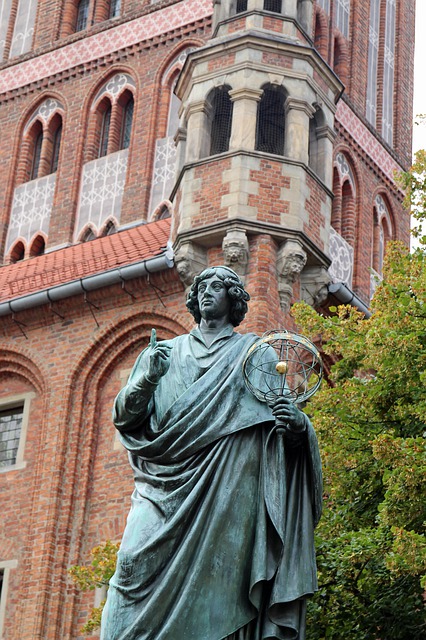By Tim Lambert
His Early Life
Nicolaus Copernicus was one of the great astronomers of the 16th century. He was born on 19 February 1473 in the Polish town of Torun. (His real name was Mikolaj Kopernik although he is better known by his Latin name). His father was a rich merchant and Nicolaus was one of 4 children. (He had 1 brother and 2 sisters). In 1491 Copernicus went to the University of Cracow. He left there about 1495. In 1496 he went to the University of Bologna to study law. By then Copernicus had become interested in astronomy.
Copernicus left Bologna in 1501. He then studied medicine at the University of Padua. From 1503 to 1510 he worked as a secretary and physician to his uncle who was a bishop. Meanwhile, he continued to study astronomy.
His Theory
An ancient Greek called Aristarchus (c 310-230 BC) correctly realized that the Earth orbits the Sun. Unfortunately, his ideas were rejected and people came to believe that the Earth is the center of the universe. They believed that the Moon, the Sun, and the other planets orbit the Earth. Copernicus realized that this was not so. The Sun is the center of the Solar System and the Earth and the other planets orbit it. This is called the Heliocentric system from the Greek word for Sun, Helios. (The older theory that the Earth is the center is called the Ptolemaic System after a Roman astronomer named Ptolemy (c 87-170 AD). Copernicus also realized that the Earth spins on its axis. The axis is tilted. That accounts for the seasons.
However, the theory that the Earth is the center of the Universe raised an awkward question. Aristotle taught that objects fall to the Earth because it is at the center of the Universe and it is natural for them to fall towards the center. If Copernicus was right then what caused objects to fall to the Earth? (Remember this was long before the theory of gravity). Furthermore, if the Heliocentric theory was true then the Earth was just another planet, part of the Heavens. But people believed the Heavens were constant and unchanging. How could the Earth be part of the Heavens when it was constantly changing? If Copernicus was correct it called people’s other beliefs about the world into question.
Copernicus worked out his new theory and wrote a manuscript but he only circulated it among close friends. He needed to make many mathematical calculations before he could publish his new theory. Finally, by 1540 he was ready. The theory was published in 1543. The book was called On the Revolutions of the Heavenly Bodies. It was dedicated to Pope Paul III.
Shortly afterward on 24 May 1543, Copernicus died. However, after his death, Copernicus became famous throughout Europe. Yet it was a long time before the Copernican Heliocentric theory was widely accepted. In 1588 Tycho Brahe put forward an alternative system in which the other planets orbited the Sun and the Sun, in turn, orbited the Earth. Yet by the middle of the 17th century, the Copernican theory was generally accepted.

There is a crater on the Moon named after Copernicus.